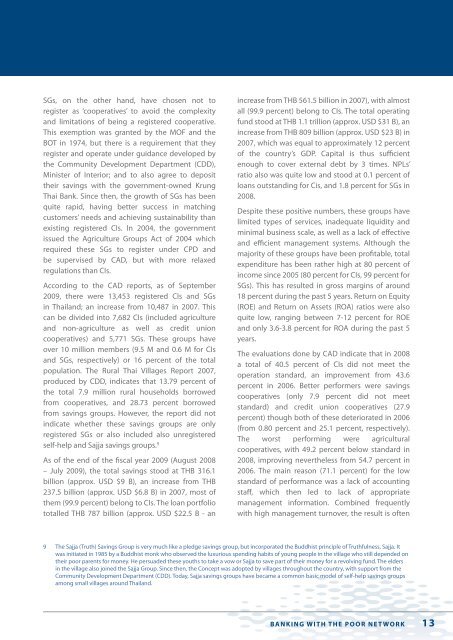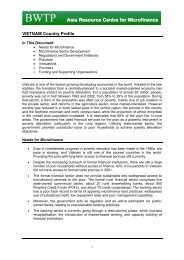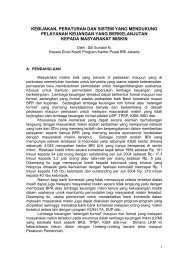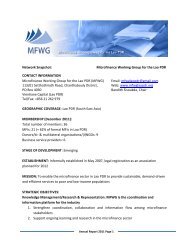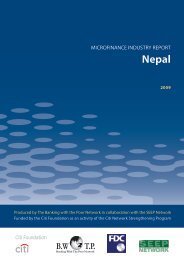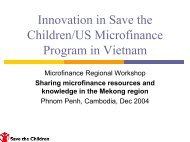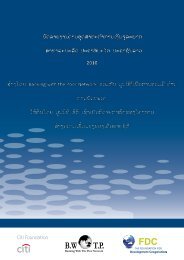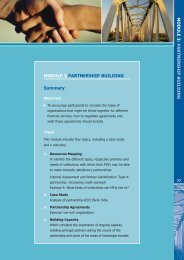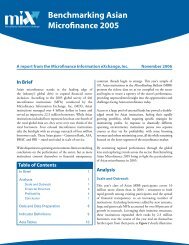MICROFINANCE INDUSTRY REPORT Thailand - Banking with the ...
MICROFINANCE INDUSTRY REPORT Thailand - Banking with the ...
MICROFINANCE INDUSTRY REPORT Thailand - Banking with the ...
You also want an ePaper? Increase the reach of your titles
YUMPU automatically turns print PDFs into web optimized ePapers that Google loves.
SGs, on <strong>the</strong> o<strong>the</strong>r hand, have chosen not toregister as ‘cooperatives’ to avoid <strong>the</strong> complexityand limitations of being a registered cooperative.This exemption was granted by <strong>the</strong> MOF and <strong>the</strong>BOT in 1974, but <strong>the</strong>re is a requirement that <strong>the</strong>yregister and operate under guidance developed by<strong>the</strong> Community Development Department (CDD),Minister of Interior; and to also agree to deposit<strong>the</strong>ir savings <strong>with</strong> <strong>the</strong> government-owned KrungThai Bank. Since <strong>the</strong>n, <strong>the</strong> growth of SGs has beenquite rapid, having better success in matchingcustomers’ needs and achieving sustainability thanexisting registered CIs. In 2004, <strong>the</strong> governmentissued <strong>the</strong> Agriculture Groups Act of 2004 whichrequired <strong>the</strong>se SGs to register under CPD andbe supervised by CAD, but <strong>with</strong> more relaxedregulations than CIs.According to <strong>the</strong> CAD reports, as of September2009, <strong>the</strong>re were 13,453 registered CIs and SGsin <strong>Thailand</strong>; an increase from 10,487 in 2007. Thiscan be divided into 7,682 CIs (included agricultureand non-agriculture as well as credit unioncooperatives) and 5,771 SGs. These groups haveover 10 million members (9.5 M and 0.6 M for CIsand SGs, respectively) or 16 percent of <strong>the</strong> totalpopulation. The Rural Thai Villages Report 2007,produced by CDD, indicates that 13.79 percent of<strong>the</strong> total 7.9 million rural households borrowedfrom cooperatives, and 28.73 percent borrowedfrom savings groups. However, <strong>the</strong> report did notindicate whe<strong>the</strong>r <strong>the</strong>se savings groups are onlyregistered SGs or also included also unregisteredself-help and Sajja savings groups. 9As of <strong>the</strong> end of <strong>the</strong> fiscal year 2009 (August 2008– July 2009), <strong>the</strong> total savings stood at THB 316.1billion (approx. USD $9 B), an increase from THB237.5 billion (approx. USD $6.8 B) in 2007, most of<strong>the</strong>m (99.9 percent) belong to CIs. The loan portfoliototalled THB 787 billion (approx. USD $22.5 B - anincrease from THB 561.5 billion in 2007), <strong>with</strong> almostall (99.9 percent) belong to CIs. The total operatingfund stood at THB 1.1 trillion (approx. USD $31 B), anincrease from THB 809 billion (approx. USD $23 B) in2007, which was equal to approximately 12 percentof <strong>the</strong> country’s GDP. Capital is thus sufficientenough to cover external debt by 3 times. NPLs’ratio also was quite low and stood at 0.1 percent ofloans outstanding for Cis, and 1.8 percent for SGs in2008.Despite <strong>the</strong>se positive numbers, <strong>the</strong>se groups havelimited types of services, inadequate liquidity andminimal business scale, as well as a lack of effectiveand efficient management systems. Although <strong>the</strong>majority of <strong>the</strong>se groups have been profitable, totalexpenditure has been ra<strong>the</strong>r high at 80 percent ofincome since 2005 (80 percent for CIs, 99 percent forSGs). This has resulted in gross margins of around18 percent during <strong>the</strong> past 5 years. Return on Equity(ROE) and Return on Assets (ROA) ratios were alsoquite low, ranging between 7-12 percent for ROEand only 3.6-3.8 percent for ROA during <strong>the</strong> past 5years.The evaluations done by CAD indicate that in 2008a total of 40.5 percent of CIs did not meet <strong>the</strong>operation standard, an improvement from 43.6percent in 2006. Better performers were savingscooperatives (only 7.9 percent did not meetstandard) and credit union cooperatives (27.9percent) though both of <strong>the</strong>se deteriorated in 2006(from 0.80 percent and 25.1 percent, respectively).The worst performing were agriculturalcooperatives, <strong>with</strong> 49.2 percent below standard in2008, improving never<strong>the</strong>less from 54.7 percent in2006. The main reason (71.1 percent) for <strong>the</strong> lowstandard of performance was a lack of accountingstaff, which <strong>the</strong>n led to lack of appropriatemanagement information. Combined frequently<strong>with</strong> high management turnover, <strong>the</strong> result is often9 The Sajja (Truth) Savings Group is very much like a pledge savings group, but incorporated <strong>the</strong> Buddhist principle of Truthfulness, Sajja. Itwas initiated in 1985 by a Buddhist monk who observed <strong>the</strong> luxurious spending habits of young people in <strong>the</strong> village who still depended on<strong>the</strong>ir poor parents for money. He persuaded <strong>the</strong>se youths to take a vow or Sajja to save part of <strong>the</strong>ir money for a revolving fund. The eldersin <strong>the</strong> village also joined <strong>the</strong> Sajja Group. Since <strong>the</strong>n, <strong>the</strong> Concept was adopted by villages throughout <strong>the</strong> country, <strong>with</strong> support from <strong>the</strong>Community Development Department (CDD). Today, Sajja savings groups have became a common basic model of self-help savings groupsamong small villages around <strong>Thailand</strong>.<strong>Banking</strong> With The Poor Network 13


